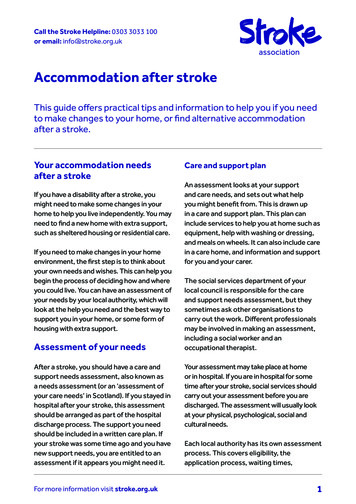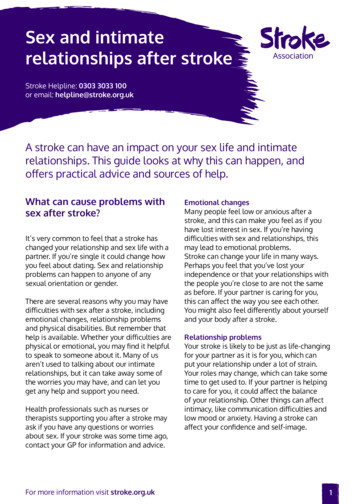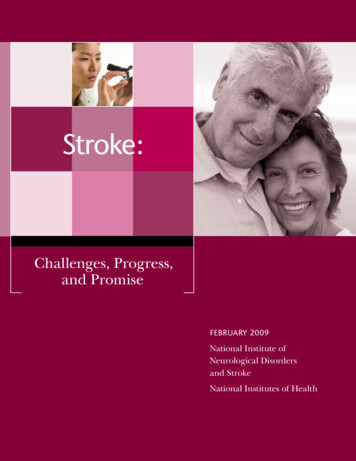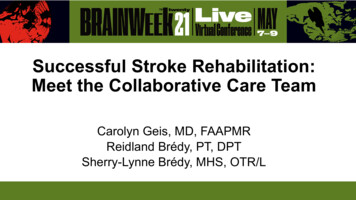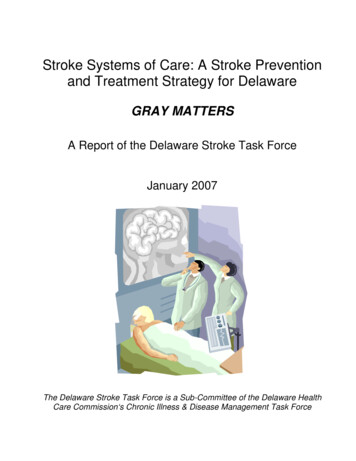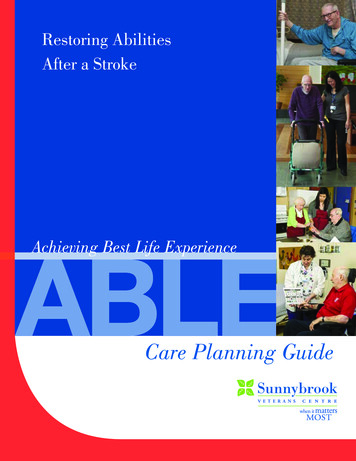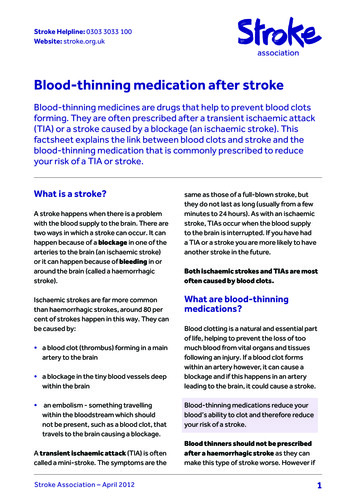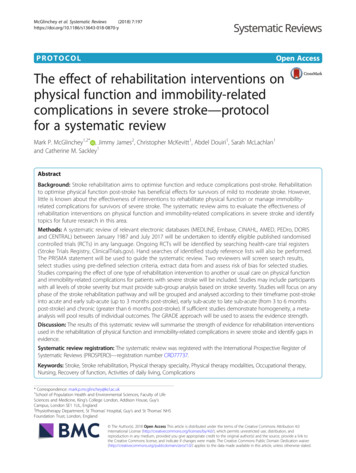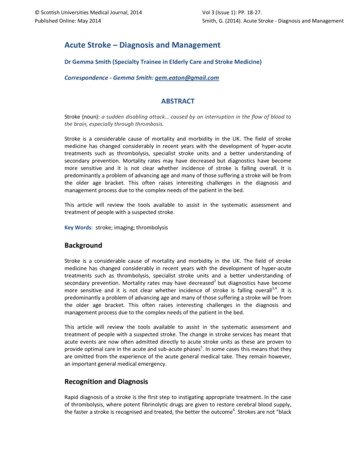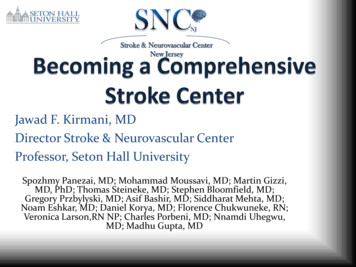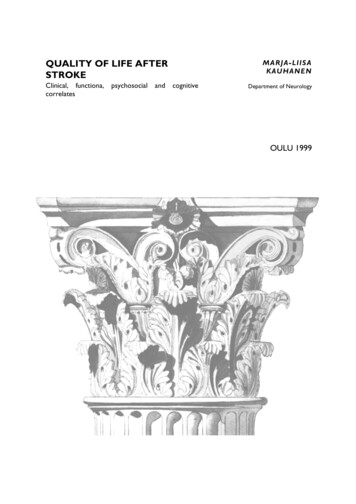
Transcription
QUALITY OF LIFE AFTERSTROKEClinical, functiona,correlatespsychosocialandMAR JA- LIISAKA UHANE NcognitiveDepartment of NeurologyOULU 1999
MARJA-LIISA KAUHANENQUALITY OF LIFE AFTER STROKEClinical, functiona, psychosocial and cognitive correlatesAcademic Dissertation to be presented with the assentof the Faculty of Medicine, University of Oulu, for publicdiscussion in Auditorium 1 of the University Hospital ofOulu, on November 19th, 1999, at 12 noon.O U L U N Y L I O P I S TO , O U L U 1 9 9 9
Copyright 1999Oulu University Library, 1999Manuscript received 27 October 1999Accepted 01 November 1999Communicated byDocent Taisto SiirtolaPh.D. Jukka TurkkaISBN 951-42-5427-9(URL: http://herkules.oulu.fi/isbn9514254279/)ALSO AVAILABLE IN PRINTED FORMATISBN 951-42-5426-0ISSN 0355-3221(URL: http://herkules.oulu.fi/issn03553221/)OULU UNIVERSITY LIBRARYOULU 1999
Quality of Life After StrokeClinical, functional, psychosocial and cognitive correlatesMarja-Liisa KauhanenDepartment of Neurology, University of Oulu andDepartment of Rehabilitation, Oulu Deaconess Institute
To my family
Kauhanen, Marja-Liisa, Quality of life after stroke. Clinical, functional,psychosocial and cognitive correlatesDepartment of Neurology, University of Oulu, FIN-90220 Oulu, and Department ofRehabilitation, Oulu Deaconess Institute, Isokatu 63, FIN-90120 Oulu, FinlandActa Univ. Oul. D 559, 1999Oulu, Finland(Manuscript received 27October 1999)AbstractDepression is a common consequence of stroke and it is known to be associated with deteriorationof quality of life. However, only limited information is available on the relationships betweendepression and communicative and cognitive disorders. Moreover, the present knowledge of thedeterminants of the domains of quality of life is limited, and little is known of e.g. the changes insexual behaviour of stroke patients and their spouses.This prospective study was carried out to evaluate the prevalence of post-stroke depression andaphasia and to study their interrelationships and neuropsychological and functional correlates. Theparticular aim of the study was to investigate the domain-specific quality of life, and to assess itsclinical and sociodemographic correlates, and to study the impact of stroke on the sexual functionsof stroke patients and their spouses. The study consisted of 156 first-ever stroke patients.Depression was diagnosed in 53% of the patients at 3 months and in 42% of the patients at 12months post-stroke according to DSM-III-R-criteria. One third of the patients were aphasic, 70% ofthem at 3 months and 62% at 12 months after stroke suffering from depression. Among the aphasicpatients the prevalence of major depression increased from 11% to 33% during the 12 months’follow-up. There was an association between post-stroke depression and cognitive impairment, thedomains most likely to be defective being memory, non-verbal problem solving, and attention andpsychomotor speed. The non-verbal neuropsychological test performance in the aphasic patientswas significantly inferior to that of the patients with dominant hemisphere lesion without aphasia.The quality of life of the patients was low at 3 months after the stroke, and it did not improveduring the follow-up of a year. The test domains most often impaired were Physical functioning,Physical role limitations, Vitality and General health. Depression, although mostly minor, and beingmarried emerged as significant independent contributors to low score value of Vitality and Physicalrole limitations. All the analyzed aspects of sexuality were commonly decreased as a consequenceof stroke both in the patients and their spouses. Nocturnal erections were impaired in 21 (55%) ofthe male patients.The present results demonstrate that more than half of the patients after stroke suffer fromdepression and the frequency of major depression seems to increase over time, especially among theaphasic patients. Both depression and aphasia increase the liability of cognitive deficits. Strokeaffects various dimensions of quality of life extensively, and the most important determinantsentailing low quality of life seem to be depression, and, interestingly, being married. As a part ofquality of life, sexual function and satisfaction with sexual life are impaired both in stroke patientsand spouses. These findings call for multidimensional evaluation of stroke patients and provide newchallenges for stroke rehabilitation.Keywords: cerebrovascular disorders, mood disorders, cognition, outcome
6
AcknowledgementsThis work was carried out at the Department of Neurology, University of Oulu, and at theDepartment of Neurological Rehabilitation, Oulu Deaconess Institute, during the years1994-1999. I was lucky to carry the present work in the excellent research team of theDepartment of Neurology with its encouraging and supporting atmosphere.I wish to express my deepest gratitude to Vilho Myllylä, M.D., Professor of Neurologyand Dean of the Faculty of Medicine, University of Oulu, who has been my teacher andsupervisor in the scientific work. I am grateful to him for his excellent guidance, supportand everlasting encouragement throughout the years of the study.I am deeply grateful to Docent Juha Korpelainen, M.D., for his tireless support andpatience in guiding me in the fields of the scientific world. His wide knowledgeconcerning cerebrovascular diseases and optimistic enthusiasm has been of invaluableimportance for the completion of this work.I express my sincere gratitude to Docent Kyösti Sotaniemi, M.D., the Director of theStroke Unit of the Department of Neurology, for his support and encouraging criticism,which have been essential for accomplishment of this work. I have been impressed by hiswide experience both in clinical and scientific work and by his logical way of thinking.I wish to thank Professor Matti Hillbom, M.D., the Head of the Department ofNeurology, for placing the research facilities for the study.My special thanks are due to Pirkko Hiltunen, M.D., for her co-operation andexperience in psychiatric disorders of stroke patients. I am grateful to her forunderstanding and sharing with me the experience of being a mother, a physician and aresearcher at the same time.I also express my gratitude to Helinä Mononen, M.A. and Elina Brusin, Ph.Lic., whohave carried out the neuropsychological studies, and to Raili Määttä, M.A., whoevaluated the verbal functions of the patients. They all have helped me to understand theworld of neuropsychology and aphasiology. My warmest thanks are due to Heini Kemolaand Ulla Malinen, nurses in the Department of Neurological Rehabilitation of OuluDeaconess Institute, for their warm and considerate attitude to patients when examiningtheir sexual functions.
My warm thanks are also due to Docent Pentti Nieminen, M.Sc., for his help andpatient guidance in the statistical problems, and to Ian Morris-Wilson, Ph.Lic., for expertrevising of the English Language of the manuscript.I want to express my gratitude to Jukka Turkka, M.D., Ph.D., and Docent TaistoSiirtola, M.D., for careful reviewing the final manuscript.I also wish to thank Docent Jarmo Karpakka, M.D., the former Director of the Hospitalof Oulu Deaconess Institute, for his support during the study. I express my special thanksto all the colleagues and friends in the Department of Rehabilitation of Oulu DeaconessInstitute, for sharing the joys and sorrows in work during these years. My warm thanksare also due to the staff of the Department of Neurology for their co-operation and helpthroughout the years of the study.l am grateful to my parents, my sisters and brothers and their families. I have beenlucky to be a member of a great, big family, who care and support each other.Finally, I express my warmest thanks to my family: to my husband Martti, and to ourchildren who have grown up to young adults during these years. I am deeply grateful toMartti for his love, I would be lost without him. I admire the creativeness of Juho and thecourage to be himself. I am grateful to Anni for her understanding and empathy. Iida andAleksi give a lot of joy to my life, their positive attitude to life inspires me.This work was supported by the grants from the Neurological Foundation, the UuloArhio Foundation, Oy H. Lundbeck Ab and Oulu University Hospital.Oulunsalo, October 1999Marja-Liisa Kauhanen
AbbreviationsADLactivities of daily livingBIBarthel IndexCTcomputed tomographyDSMDiagnostic and Statistical Manual of Mental DisordersMMSEMini Mental State ExaminationMRImagnetic resonance imagingORodds ratioPSDpost-stroke depressionQOLquality of lifeRAND 36RAND 36-Item Health SurveyRankinRankin ScaleSDstandard deviationSF-36MOS 36-Item Short-Form Health SurveySPSSStatistical Package for Social SciencesSSSScandinavian Stoke ScaleWABWestern Aphasia BatteryWAISWechsler Adult Intelligence ScaleWHOWorld Health OrganizationWMSWechsler Memory ScaleZDSZung Self-rating Depression Scale
List of original papersThis thesis is based on the following articles, which will be referred to in the text by theirRoman numerals:IKauhanen M-L, Korpelainen JT, Hiltunen P, Brusin E, Mononen H, Määttä R,Nieminen P, Sotaniemi KA & Myllylä VV (1999) Post-stroke depression correlateswith cognitive impairment and neurological deficits. Stroke 30: 1875-1880.IIKauhanen M-L, Korpelainen JT, Hiltunen P, Määttä R, Mononen H, Brusin E,Sotaniemi KA & Myllylä VV. Aphasia, depression and non-verbal cognitiveimpairment in ischaemic stroke. Submitted for publication.IIIKauhanen M-L, Korpelainen JT, Hiltunen P, Nieminen P, Sotaniemi KA & MyllyläVV. Domains and determinants of quality of life after brain infarction. Submitted forpublication.IVKorpelainen JT, Kauhanen M-L, Kemola H, Malinen U & Myllylä VV (1998)Sexual dysfunction in stroke patients. Acta Neurol Scand 98: 400-405.
12
ContentsAbstractAcknowledgementsAbbreviationsList of original papers1. Introduction . . . . . . . . . . . . . . . . . . . . . . . . . . . . . . . . . . . . . . . . . . . . . . . . . . . . . . . .2. Review of the literature . . . . . . . . . . . . . . . . . . . . . . . . . . . . . . . . . . . . . . . . . . . . . . .2.1. General aspects of stroke . . . . . . . . . . . . . . . . . . . . . . . . . . . . . . . . . . . . . . . . . .2.2. Post-stroke depression . . . . . . . . . . . . . . . . . . . . . . . . . . . . . . . . . . . . . . . . . . . .2.2.1. General aspects of post-stroke depression . . . . . . . . . . . . . . . . . . . . . . .2.2.2. Measurement and diagnosis of post-stroke depression . . . . . . . . . . . . .2.2.3. Cognitive impairment and post-stroke depression . . . . . . . . . . . . . . . . .2.2.4. Other clinical and functional correlates of post-stroke depression . . . .2.3. Post-stroke aphasia . . . . . . . . . . . . . . . . . . . . . . . . . . . . . . . . . . . . . . . . . . . . . . .2.3.1. Occurrence of aphasia . . . . . . . . . . . . . . . . . . . . . . . . . . . . . . . . . . . . . .2.3.2. Depression in aphasic stroke patients . . . . . . . . . . . . . . . . . . . . . . . . . .2.3.3. Other clinical and functional correlates of aphasia . . . . . . . . . . . . . . . .2.4. Quality of life after stroke . . . . . . . . . . . . . . . . . . . . . . . . . . . . . . . . . . . . . . . . .2.4.1. General aspects of quality of life . . . . . . . . . . . . . . . . . . . . . . . . . . . . . .2.4.2. Measurement of quality of life in stroke patients . . . . . . . . . . . . . . . . .2.4.3. Determinants of post-stroke quality of life . . . . . . . . . . . . . . . . . . . . . .2.4.4. Sexual functioning after stroke . . . . . . . . . . . . . . . . . . . . . . . . . . . . . . .3. Aim of the study . . . . . . . . . . . . . . . . . . . . . . . . . . . . . . . . . . . . . . . . . . . . . . . . . . . .4. Subjects and methods . . . . . . . . . . . . . . . . . . . . . . . . . . . . . . . . . . . . . . . . . . . . . . . .4.1. Subjects . . . . . . . . . . . . . . . . . . . . . . . . . . . . . . . . . . . . . . . . . . . . . . . . . . . . . . .4.2. Methods . . . . . . . . . . . . . . . . . . . . . . . . . . . . . . . . . . . . . . . . . . . . . . . . . . . . . . .4.2.1. Clinical examination . . . . . . . . . . . . . . . . . . . . . . . . . . . . . . . . . . . . . . .4.2.2. Psychiatric examination . . . . . . . . . . . . . . . . . . . . . . . . . . . . . . . . . . . . .4.2.3. Neuropsychological examination (I-II) . . . . . . . . . . . . . . . . . . . . . . . . .4.2.4. Evaluation of verbal functions (I-II) . . . . . . . . . . . . . . . . . . . . . . . . . . .4.2.5. Evaluation of quality of life (III) . . . . . . . . . . . . . . . . . . . . . . . . . . . . .4.2.6. Evaluation of sexual functions (IV) . . . . . . . . . . . . . . . . . . . . . . . . . . . .4.2.6.1. Questionnaire . . . . . . . . . . . . . . . . . . . . . . . . . . . . . . . . . . . . . .4.2.6.2. Measuring nocturnal penile erection . . . . . . . . . . . . . . . . . . . 232323232
4.2.7. Statistical methods . . . . . . . . . . . . . . . . . . . . . . . . . . . . . . . . . . . . . . . . .5. Results . . . . . . . . . . . . . . . . . . . . . . . . . . . . . . . . . . . . . . . . . . . . . . . . . . . . . . . . . . . .5.1. Post-stroke depression . . . . . . . . . . . . . . . . . . . . . . . . . . . . . . . . . . . . . . . . . . . .5.1.1. Prevalence and course of post-stroke depression . . . . . . . . . . . . . . . . .5.1.2. Correlates of post-stroke depression . . . . . . . . . . . . . . . . . . . . . . . . . . .5.2. Post-stroke aphasia . . . . . . . . . . . . . . . . . . . . . . . . . . . . . . . . . . . . . . . . . . . . . . .5.2.1. Prevalence and evolution of aphasia . . . . . . . . . . . . . . . . . . . . . . . . . . .5.2.2. Post-stroke depression in aphasic patients . . . . . . . . . . . . . . . . . . . . . . .5.2.3. Other correlates of post-stroke aphasia . . . . . . . . . . . . . . . . . . . . . . . . .5.3. Post-stroke quality of life . . . . . . . . . . . . . . . . . . . . . . . . . . . . . . . . . . . . . . . . . .5.3.1. Domains and determinants of quality of life . . . . . . . . . . . . . . . . . . . . .5.3.2. Sexual function after stroke . . . . . . . . . . . . . . . . . . . . . . . . . . . . . . . . . .6. Discussion . . . . . . . . . . . . . . . . . . . . . . . . . . . . . . . . . . . . . . . . . . . . . . . . . . . . . . . . .6.1. General aspects . . . . . . . . . . . . . . . . . . . . . . . . . . . . . . . . . . . . . . . . . . . . . . . . . .6.2. Post-stroke depression . . . . . . . . . . . . . . . . . . . . . . . . . . . . . . . . . . . . . . . . . . . .6.2.1. Prevalence and course of post-stroke depression . . . . . . . . . . . . . . . . .6.2.2. Neuropsychological and clinical correlates of post-stroke depression .6.3. Aphasia after stroke . . . . . . . . . . . . . . . . . . . . . . . . . . . . . . . . . . . . . . . . . . . . . .6.3.1. Prevalence and course of post-stroke aphasia . . . . . . . . . . . . . . . . . . . .6.3.2. Depression in aphasic patients after stroke . . . . . . . . . . . . . . . . . . . . . .6.3.3. Other clinical correlates of post-stroke aphasia . . . . . . . . . . . . . . . . . . .6.4. Quality of life after stroke . . . . . . . . . . . . . . . . . . . . . . . . . . . . . . . . . . . . . . . . .6.4.1. Domains and determinants of post-stroke quality of life . . . . . . . . . . . .6.4.2. Sexual dysfunction in stroke patients and spouses . . . . . . . . . . . . . . . .7. Conclusions . . . . . . . . . . . . . . . . . . . . . . . . . . . . . . . . . . . . . . . . . . . . . . . . . . . . . . . .8. References . . . . . . . . . . . . . . . . . . . . . . . . . . . . . . . . . . . . . . . . . . . . . . . . . . . . . . . . 253
1. IntroductionStroke is a leading cause of long-term disability in western countries causing majorindividual, social and economic burdens. In spite of a declining trend in the incidence ofstroke figures in Finland during the last few decades (Kotila 1984, Sarti 1994,Tuomilehto et al. 1996), an increase can be expected in the population at risk of strokedue to extended life expectancy.Improving the quality of life (QOL) of stroke patients has received increasing attentionas a part of the development of therapeutic strategies during the last decade (Hachinski1999). Stroke patients have often been reported to have lower QOL than control subjectsof similar age (Åström et al. 1992, Jonkman et al. 1998, Wyller et al. 1998), but contraryto these findings, King (1996) found stroke patients coping well with their stroke relatedimpairments.Mood disorders are a common but often unrecognized companion of stroke. Thereported prevalence of post-stroke depression (PSD) varies from 20% to 65% (Primeau1988, Robinson 1997). PSD is known to be related to dependence in activities of dailyliving (ADL) and to the severity of neurological deficits (Sinyor et al. 1986, Åström et al.1993, Kotila et al. 1998), but the knowledge of its neuropsychological correlates islimited. Although clinical experience has shown that aphasia may markedly influence theseverity and persistence of PSD, psychiatric evaluations of aphasic patients are very few(Åström et al. 1993, Sharpe et al. 1994).PSD has been reported in some studies (Niemi et al. 1988, Åström et al. 1992,Angeleri et al. 1993) as being related to impaired QOL, but only in one of these studieswas the diagnosis of depression based on psychiatric evaluation (Åström et al. 1992).Women tend to have poorer health and QOL in the general population (Jenkinson et al.1993), but knowledge of the impact of gender and marital status on post-stroke QOL islimited. Although sexuality is a vital part of QOL, little information is available ofchanges in the sexuality of stroke patients and their spouses. Moreover, no measures ofe.g. nocturnal penile tumescence of the male patients have been used.The interpretation of QOL findings may be complicated by the wide variety in themethods used in evaluation of QOL (de Haan 1993, Williams 1998), by simultaneousgrading of pre- and post-stroke QOL (Ahlsiö et al. 1984, Niemi et al. 1988, Viitanen et al.1988), which may lead to overestimation of the pre-stroke condition, as well as by a
16heterogeneity of time elapsed after the onset of stroke (Viitanen et al. 1988). The patientswith moderate or severe aphasia and cognitive disorders have usually been excluded fromthe studies of PSD (Starkstein & Robinson 1988, Herrmann et al. 1993, Åström et al.1993), although these patients are an important subpopulation in any investigation of PSDand its correlates. Very few prospective studies have been carried out using bothneuropsychological tests to evaluate cognitive impairment and psychiatric examinationsto diagnose depression after stroke.The present prospective study was designed to examine the relationships between PSDand neuropsychological and functional deficits in patients with first-ever brain infarction,and to study the evolution of aphasia and its interrelationship with psychiatric,neurological and cognitive disorders. In particular, the study aimed at evaluating thedomain-specific QOL, and assessing its clinical and sociodemographic correlates. As apart of QOL assessment, the study also aimed to examine the impact of stroke on thesexual behaviour of stroke patients and their spouses.
2. Review of the literature2.1. General aspects of strokeStroke is a major health problem in all industrialized countries. It is the third leadingcause of death and leaves many of its survivors with physical and mental disabilities, thuscreating a major social and economic burden. (Kaste et al. 1998)According to the World Health Organization (WHO) stroke is defined as “rapidlydeveloping clinical signs of focal (or global) disturbance of cerebral function, lastingmore than 24 hours or leading to death, with no apparent cause other than vascular origin”(Aho et al. 1980). In 70-80% of cases stroke is caused by brain infarctions, in 9-15% byintracerebral hemorrhages and in about 10% by subarachnoid hemorrhages (Sivenius1982, Rissanen 1992, Kaste et al. 1995, Numminen et al. 1996, Kaste et al. 1998).Stroke afflicts all ages, but the incidence increases with advanced age (Kotila 1984,Dobkin 1995, Numminen et al. 1996). The incidence rate is generally greater in malesaged under 65 years than females, but it equalizes with increasing age (Kotila 1984,Reunanen et al. 1986, Rissanen 1992, Numminen et al. 1995). There has been a decliningtrend in the stroke incidence in Finland since the 1970s (Aho 1975, Kotila 1984, Sarti etal. 1994, Numminen et al. 1996, Tuomilehto et al. 1996), but as public health, medicaland social advances continue to extend life expectancy, we can expect an increase in thesize of the population at risk of stroke (Special Report From the World HealthOrganization 1989).Stroke is the most important cause of physical disability in people over 60 years of age(Kaste et al. 1995). Hemiparesis is the most constant neurologic finding, its frequency inthe acute stage varying from 70 to 85% (Sivenius 1982, Kotila 1986, Rissanen 1992,Dobkin 1995). The neurological deficits often improve during the first months up to oneyear so that after a year about 22% of patients are dependent in walking (Gresham et al.1979, Rissanen 1992). Most of the patients (53-76%) are independent in ADL after ayear, 8-28% being totally dependent on the help of other people (Sivenius 1982, Kotila1986, Aho et al. 1986, Rissanen 1992).Disturbances of speech are quite common in the acute phase, the frequency of aphasiavarying from 20% to 38% and declining to 12-28% after 6 months (Sivenius 1982, Kotila1986, Wade et al. 1986, Dobkin 1995, Pedersen et al. 1995). Cognitive impairment has
18been found in 27% to 35% of patients at 3 months after ischemic stroke, the domainsmost likely to be defective being memory, orientation, language, attention andvisuospatial functions (Tatemichi et al. 1994, Pohjasvaara 1998). Kotila (1986) foundvisuoperceptual deficits in 60% of patients at 3 months and in 41% at 12 months poststroke, and memory dysfunction in 55% and 31%, respectively.2.2. Post-stroke depression2.2.1. General aspects of post-stroke depressionDepression is an ever-present and often unrecognized problem after stroke having bothbiological and psycho-social dimensions (Hachinski 1999). The reported prevalence ofPSD varies from 20% to 65% depending on the selection of patients, diagnostic criteriaand the time elapsed after stroke (Primeau 1988, House et al. 1991, Åström et al. 1993,Robinson 1997, Kotila et al. 1998). Robinson et al. (1987) found in a subsample of theiroriginal group a stable prevalence of depression for up to 2 years. All the patients withmajor depression in-hospital had improved during the follow-up, but the prognosis ofminor depression was unfavorable, only 30% of follow-up patients with minor depressionbeing improved within 2 years. In other studies the majority of patients with majordepression experienced remission within the first year (House et al. 1991, Åström et al.1993). However, a minority of patients had not recovered by one year and were at a highrisk of chronic depression (Åström et al. 1993). Table 1 presents the earlier cohortsexamining PSD.The estimation of the PSD rates must be looked at cautiously because of the differentmethods used for selecting the study populations and the different methods of diagnosis.Many of the earlier reports can be criticized for their small study samples (Robinson &Price 1982, Robinson et al. 1986, Morris et al. 1992) and for the exclusion of patientswith aphasia and comprehensive deficits (House 1987). Moreover, some studies have notexcluded patients with a previous history of depression (Åström et al. 1993, Palomäki etal. 1999). The diagnosis of PSD has often been based on self-report inventories, whichmay produce unreliable results due to the patients’ verbal and cognitive deficits (House1987, Gordon & Hibbard 1997).The etiology of PSD has aroused interest in many investigators. Some investigatorsclaim that the etiology of PSD is a complex mixture of pre-stroke personal and socialfactors and it arises as a psychological reaction to stroke induced impairments and socialhandicap (House 1987, House et al. 1991, Andersen et al. 1995). The opposite conclusionof Lyketsos et al. (1998) is that “stroke lesions, under certain circumstances, causedepression through a direct but unknown pathophysiologic process”. This claim has beensupported by many studies (Robinson et al. 1984, Herrmann et al. 1993, Åström et al.1993) showing that left anterior brain lesion is the most important predictor of majordepression in the acute phase, but there are also opposite claims (Herrmann et al. 1995,Herrmann et al. 1998, Pohjasvaara et al. 1998). In conclusion, the etiology of PSD seemsto be multi-factorial including both pre-stroke personal and social factors, stroke inducedpsychological reactions and organic backgrounds.
MADRS,DSM-III-Rneurological impairment, female,previous history of depressionlarge lesion volume, female,functional dependenceacute phase: left anterior lesion,aphasia, living alone3 months: dependence in ADL12 months: few social contactscognitive impairment measuredby MMSECorrelates of PSD48%40%, major 26%, minor 14%localization of infarct in carotidterritory, severe disability, badgeneral outcomeneurological impairment, female,previous history of depression3 months: activeage 70 years, severe SSS progprograms 42%nostic scorecontrol districts 54%12 months: active programs 42%control districts 55%3 months: ZDS 22%MADRS 27%12 months: ZDS 21%MADRS 22%18%acute phase: 25%3 months: 31%1 year: 16%2 years: 19%3 years: 29%major depression 29%minor depression 26%Prevalence of PSDHDS; Hamilton Depression Scale, ZDS; Zung Self-rating Depression Scale, PSE; Present State Examination, DSM-III: Diagnostic and Statistical manual of MentalDisorders, MADRS; Montgomery Asberg Depression Rating Scale, BDI; Beck’ Depression Inventory,n 65, mean age 36 yearsat 12 to 59 monthsMADRS, ZDSNeau et al.1998at 3 and 12 monthsDSM-III-RPSE,DSM-III-Rn 150, mean age 75 yearsHerrmann et al.1998at 3 to 5 years afterfirst strokeat 3 to 4 monthsn 60, 33 75 years27 75 yearsSharpe et al.1995in the acute phase, DSM-III-R, majorat 3 months and at 1, depression2 and 3 yearsHDS, ZDS, PSE,DSM-IIIPohjasvaara et al. n 277, aged from 55 to 851998yearsn 80, mean age73 yearsÅström et al.1993at 2 weeks and at 6monthsDefinition of PSDBDIn 38, mean age 56 yearsRobinson et al.1986Time fromstrokeKotila et al. 1998 n 181, mean age 69 years in at 3 and 12 monthsactive programsn 140, mean age 68 years incontrol districtsN of subjects,ageStudyTable 1. Earlier stroke cohorts examining PSD.19
20Although depression is an important consequence of stroke, it is recognized andtreated in only a minority of patients (Wade et al. 1987, Åström et al. 1993, Kotila et al.1998). Selective serotonin reuptake inhibitor citalopram has been shown to be both safeand effective in the treatment of PSD (Andersen et al. 1994). On the other hand, in arecent study (Palomäki et al. 1999) early initiation of miancerin had no effect on PSD orfunctional outcome, but according to the investigators good medical care andcomprehensive and individually planned early rehabilitation may have abolished thepossibility of the antidepressant to influence PSD.2.2.2. Measurement and diagnosis of post-stroke depressionOne of the main problems in research of PSD is the diagnostic accuracy of standardizedpsychiatric assessment techniques in neurologically impaired individuals. Traditionalpsychiatric criteria for mood disorders rely heavily on patients’ own reports of theirsymptoms. This requires patients to be aware of their situation, and to be capable ofproviding an accurate report of it, and to be free of any medical conditions that couldmimic the symptomatology of depression. (Gordon & Hibbard 1997)Self-report inventories are widely used in research of PSD. These inventories,however, have a number of drawbacks. They tend to have relatively low specificities andpredictive values because the inclusion of somatic symptoms leads to high false positiverates (Goldberg 1985). The variability in awareness of their situation can influence theaccuracy of self-report inventories in stroke patients (Gordon & Hibbard 1997). Anotherimportant problem is that stroke patients may be unable to complete the investigatoryforms because of aphasia and other cognitive and physical impairments (Primeau 1988,House 1991, Gordon & Hibbard 1997). Hence, a careful psychiatric interview withmultiple sources of information about the patients’ mood from behavioral observations ofthe patients and from family members and staff is crucial for the diagnosis of PSD (House1991, Åström et al. 1993, Sharpe et al. 1994, Gordon & Hibbard 1997).Several studies have pointed out that the phenomenology of PSD contains the corefeatures associated with functional depression (Lipsey et al. 1986, Fedoroff et al. 1991,House 1991). For research purposes two types of depressive disorder have been identifiedaccording to DSM-III-R criteria (American Psychiatric Association 1987): majordepression, and minor depression which meets the criteria for dysthymic disordersignoring the 2-year criterion of DSM-III-R classification (Primeau 1988). The reliabilityof DSM-III criteria in the diagnosis of post-stroke depression has been shown in previousreports (Fedoroff et al. 1991, Sharpe et al. 1994, Robinson 1997). Fedoroff et al. (1991)compared depressive stroke patients with non-depressive ones for the frequency ofdepressive symptoms, and showed that only 3% of their depressive patients may havebeen overdiagnosed, and only 5% of their patients underdiagnosed.
212.2.3. Cognitive impairment and post-stroke depressionMany studies have demonstrated a greater degree of cognitive impairment in depressivestroke patien
RAND 36 RAND 36-Item Health Survey Rankin Rankin Scale SD standard deviation SF-36 MOS 36-Item Short-Form Health Survey SPSS Statistical Package for Social Sciences SSS Scandinavian Stoke Scale WAB Western Aphasia Battery WAIS Wechsler Adult Intelligence Scale WHO World Health Organization
